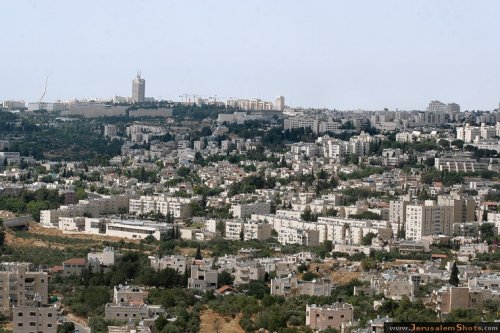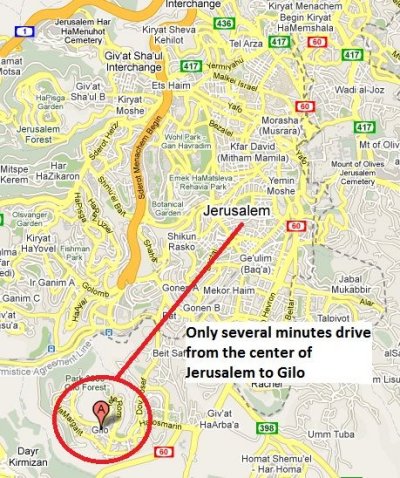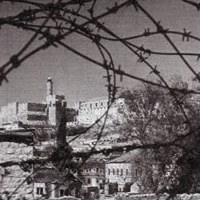Gilo is not a settlement
 By Michael Davison, Raanana: Nov 24 2009
By Michael Davison, Raanana: Nov 24 2009
Source: (Greywolf Instablogs)
Like many of Mr. Villa’s articles, the one he posted about the Gilo neighborhood has been seeded with misconceptions, half-truths and whole lies.
Gilo is not a “settlement” and never has been one, unless you consider every Israeli town, city and suburb a “settlement”, including those that were built on legally purchased and registered land, like Tel-Aviv, Petah Tikva and Rishon LeZion. This is apparently Mr. Villa’s point of view.
This post is a long one, because lies can be told with few words, but the truth requires understanding—and understanding is rarely brief:
—
Gilo and the Green Line in perspective
by Maurice Ostroff; published in The Jerusalem Post, november 22, 2009.
The international brouhaha generated by the decision to build 900 houses in the Gilo suburb of Jerusalem points to the imperative need to reach a common definition of the word “settlement” in relation to Israel. The anger expressed by the White House and echoed by the EU and even China, obviously stems from the impulsive conclusion that Gilo is a settlement, no different from the outposts in remote areas of the West Bank. To quote the bard, therein lies the rub.
The $64,000 question then, is whether Gilo is in fact a settlement and if so, what type of settlement it is. To all who prefer to analyze a situation before arriving at a conclusion it is important to look at the facts in context.
The Oxford English dictionary defines a settlement as “newly settled tract of country, or a colony,” but according to the BBC, a settlement is merely a place where people live; as small as an individual house or as large as a city. Since a settlement also refers in law, to reaching agreement by parties to a dispute, one may hope that agreeing on a commonly acceptable definition of this inflammatory word may possibly contribute to “settlement” of the Arab-Israeli conflict.
THE REALITY is that Gilo is very different than the outposts in the West Bank. It is not in east Jerusalem as widely reported. It is a Jerusalem neighborhood with a population of around 40,000. The ground was bought by Jews before WWII and settled in 1971 in south west Jerusalem opposite Mount Gilo within the municipal borders. There is no inference whatsoever that it rests on Arab land.
The current building approval was not a deliberately provocative political decision by Binyamin Netanyahu as reported in some media. The plan was initiated a long time ago by the Israel Land Administration. Since Gilo is an integral part of the city, the approval was given by Jerusalem’s Construction and Planning Committee and, as Jerusalem mayor Nir Barkat said in a statement released by his office, “Israeli law does not discriminate between Arabs and Jews, or between east and west of the city. The demand to cease construction just for Jews is illegal, as in the US and any other enlightened place in the world. The Jerusalem Municipality will continue to enable construction in every part of the city for Jews and Arabs alike.”
Ironically, Netanyahu has gone further than any previous Israeli prime minister. While continuing the policy of previous governments in refusing to consider a construction freeze in Jerusalem he unexpectedly did agree to halt construction in theWest Bank during negotiations with the Palestinians.
Secretary of State, Hillary Clinton, surprised the world and angered some, by recognizing Netanyahu’s departure from the stance of previous governments and praising his offer as “unprecedented.” She was indeed very perceptive in recognizing the extent of Netanyahu’s compliance with the demands ofthe White House.
According to a November 19 report, a cabinet minister told Ha’aretz that Netanyahu has entirely frozen building in the settlements. Ever since this government was established in April, not a single tender has been issued or plan approved, not even in east Jerusalem. And this has been done by a cabinet including ministers considered to be extreme right wingers like Bennie Begin, Moshe Ya’alon, Avigdor Lieberman, Uzi Landau and Eli Yishai. “Yet,” the minister said, “Bibi is getting clobbered, relentlessly”.
In his video message to the November 8 Rabin Rally in Tel Aviv, US President Barack Obama urged Israel to pursue Rabin’s legacy. It is therefore relevant to recall that Rabin had no intention of returning to the 1967 lines. In his last speech to the Knesset on October 5, 1995, Rabin said “The borders of the State of Israel, during the permanent solution, will be beyond the lines which existed before the Six Day War. We will not return to the 4 June 1967 lines….First and foremost, united Jerusalem – which will include both Ma’aleh Adumim and Givat Ze’ev – as the capital of Israel, under Israeli sovereignty, while preserving the rights of the members of the other faiths, Christianity and Islam, to freedom of access and freedom of worship in their holy places, according to the customs of their faiths….”
AS THE Western Wall, Ramat Eshkol, French Hill, Pisgat Ze’ev, and Mount Scopus are all beyond the Green Line, it important to consider its significance realistically. The Green line is not an international border. It refers only to the 1949 Armistice lines established after the 1948 Arab-Israeli War. Its name is derived from the green ink used to draw the line on the map. Nor is it fixed, as explained by Justice Stephen M. Schwebel, who spent 19 years as a judge of the International Court of Justice at The Hague, including three years as President. He wrote “…modifications of the 1949 armistice lines among those States within former Palestinian territory are lawful (if not necessarily desirable), whether those modifications are, in Secretary Rogers’s words, “insubstantial alterations required for mutual security” or more substantial alterations – such as recognition of Israeli sovereignty over the whole of Jerusalem..” And in a footnote he added “It should be added that the armistice agreements of 1949 expressly preserved the territorial claims of all parties and did not purport to establish definitive boundaries between them”.
The Palestinians never had sovereignty over the West Bank nor east Jerusalem and Justice Schwebel concluded that since Jordan, the prior holder of these territories had seized that territory unlawfully in 1948, Israel which subsequently took that territory in the lawful exercise of self-defense in 1967, has better title to it. Jordan’s illegal annexation of theWest bank and east Jerusalem in 1948 was recognized only by Britain and Pakistan and Jordan now makes no claim to it.
In terms of international law, between 1948 and 1967 this territory was terra nullius, or “land belonging to no one” over which sovereignty may be acquired through occupation. The concept of terra nullius is well recognized in international law. For example it has been a major issue in Australian politics and Norway occupied parts of uninhabited Eastern Greenland in the 1920s on the grounds of terra nullius.
As east Jerusalem came into Israel’s possession in the course of a defensive war, Israel was entitled to annex it and create a united Jerusalem. Consequently, the Jerusalem City Council has jurisdiction over building approvals for Jewish and Arab residence in any part of the city.
It is highly relevant that the Oslo Accords do not require any freeze of building activity and even the road map which was never formally ratified, speaks only of dismantling “outposts” erected since March 2001, a far cry from Gilo, that has been a residential suburb of Jerusalem since 1971.
In proposing solutions towards achieving two states, co-existing in peace and security, impractical slogans like ‘evacuate the settlements’ should be discarded because of their vagueness and replaced by a pragmatic call for territorial compromise taking the above realities into account.
—
Like many Israelis, I feel that the settlements in the West Bank and Gaza were a mistake for more than one reason and the resources used on them could have been put to better use elsewhere. That doesn’t mean that facts on the ground can be ignored today.
However, this has no relevance to Mr. Villa’s article on the 900 houses to be built in Gilo, since Gilo is not and never was either a “settlement or over the “Green Line” (1949 armistice line). Any idiot who knows enough to call up Google Maps and find Jerusalem can verify this. (Note from Crethi Plethi: Gilo is outside the green armistice line (agreement and end of the 1948 Arab-Israeli war), but within the Jerusalem Municipal Borders. The State of Israel has declared Jerusalem (after the six day war 1967) the undivided capitol of Israel and as such hold its right to build within the municipal borders. Also, Gilo is build on Jewish ground, as it was legally bought from arab landowners prior to WW2, which made Jordan (after 1948) an occupying force till 1967.)
Mr. Villa and many like him misunderstand the legal status of the West Bank and Gaza Strip, whether deliberately or through ignorance. This is perhaps brought about by a more basic misunderstanding of the concept so often repeated by those supporting the Palestinian Arabs who love to refer to UNSC Resolution 242: “Emphasizing the inadmissibility of the acquisition of territory by war…” without referring to other sources that clarify the statement. Under international law, acquisition of territory through a war of aggression is inadmissible. This is why Jordan’s attempted annexation of the West Bank in 1950 was rejected by the UN and Egypt discarded its intent to annex the Gaza Strip that same year. However, international law DOES allow the acquisition of territory in a defensive war as part of a negotiated settlement. Both the War of Independence in 1948 and the 6-Day War in 1967 were defined as defensive wars by the United Nations.
Even the Palestinian National Charter of 1964 waives any Palestinian claim to the Gaza Strip, West Bank and Jerusalem area in its Article 24: “This Organization does not exercise any territorial sovereignty over the West Bank in the Hashemite Kingdom of Jordan, on the Gaza Strip or in the Himmah [Jerusalem] Area.”
This article was stricken from the Charter in 1968, after the 6-Day War because these areas had changed from Arab to Israeli control. Until this change the Charter dealt only with the land on which the state of Israel was located.
When the Arab armies attacked Israel in 1948, UNGA Resolution 181 for the Partition of Palestine went out the window. Under international law, every square centimeter of land conquered by Israel outside the area allocated to the “Jewish State” was a legal acquisition, while Jordanian and Egyptian acquisitions were not. Under international law, the Gaza Strip and the West Bank are considered “disputed territories”, not “occupied territories”, since they did not legally belong to any sovereign nation. (No, Mr. Villa, there has never been a sovereign nation called Palestine—and the way things are going, I don’t know if there will ever be one. Maybe one day, politicians from both sides will get down to the real nitty-gritty of solving the conflict, rather than demanding impossible concessions from the other.)
The inadmissibility of acquisition of territory by war was specifically designed so that an aggressor could no longer benefit by embarking on a war of aggression. This is also why Israel returned the Sinai Peninsula to Egypt in 1979. Even though the 6-Day War was a defensive war on Israel’s part, the Sinai had legally belonged to Egypt before the war and the peace treaty defined the return of territory for peace—in accordance with the intent of UNSC Resolution 242. Note, however, that the Gaza Strip, which was acquired by Egypt’s aggression, was NOT returned to Egyptian control. Additionally, Jordan relinquished all claims to the West Bank and Jerusalem in the 1994 peace treaty, a tacit acknowledgment to the illegality of its claims. This underscores the status of these two areas as “terra nullius” (belonging to no one), since the Palestinian Arabs never demanded the implementation of UNGA Resolution 181 to establish a Palestinian state in these areas.
IF the Palestinian Arab aim had really been the establishment of a Palestinian state, they would have demanded that Egypt and/or Jordan relinquish their claims and allow the establishment of a Palestinian state. Since their declared objective was the destruction of Israel (an illegal aim, by the way, which violated the UN Charter), they never did so until it became clear that the Arab states would not be doing the work of destroying Israel for them. Their aim was (and apparently still is) to replace Israel with a Palestinian Arab state, not to live alongside Israel.
It’s important to remember that there was no Palestinian Nationalist movement prior to 1968, when the PLO changed the Palestinian National Charter to include the West Bank, Gaza Strip and Jerusalem in their territorial objectives. Another important point for consideration is the fact that the Palestinian Authority has recently re-ratified the 1968 Charter without changes—in direct violation of its commitment under the Oslo Accord make specific amendments regarding the aim to destroy Israel.
Apparently, the aim is still as before—the destruction of Israel. The words of Zuheir Muhsein in an interview to the Dutch newspaper “Trouw” are as relevant today as they were when it was printed:
“The Palestinian people do not exist. The creation of a Palestinian state is only a means for continuing our struggle against the state of Israel for our Arab unity. In reality today there is no difference between Jordanians, Palestinians, Syrians and Lebanese. Only for political and tactical reasons do we speak today about the existence of a Palestinian people, since Arab national interests demand that we posit the existence of a distinct ‘Palestinian people’ to oppose Zionism.
“For tactical reasons, Jordan, which is a sovereign state with defined borders, cannot raise claims to Haifa and Jaffa, while as a Palestinian, I can undoubtedly demand Haifa, Jaffa, Beer-Sheva and Jerusalem. However, the moment we reclaim our right to all of Palestine, we will not wait even a minute to unite Palestine and Jordan.”
Since Zuheir Muhsein was, at the time, a member of the PLO Executive Committee, I think we can assume that he knew what he was talking about. One has to wonder what the Jordanian government thinks of this aim…
Jerusalem is a different matter, since it was never allocated to either the Jewish state or the Arab state under UNGA Resolution 181, but was intended to be administrated by a UN committee as an international zone, and again falls under the status of “terra nullius” thanks to the Arab aggression of 1948.
Under any circumstances, the Gilo neighborhood can not be considered a “settlement” since it is not, and never was on land that could be considered “Palestinian” by any stretch of the imagination. Mr. Villa’s ire at the expansion of a purely Israeli neighborhood is merely a gratis expression of his unbridled hatred of Israel, apparent in many of his posts, which depend on the liberal use of buzzwords, slogans, facts not in evidence, half-truths and whole lies. Mr. Villa, why don’t you protest the expansion of Natanya’s Ramat Poleg neighborhood as well? You have just as much justification and just as much legal ground to do so—that is, ZILCH, zero, zip, nada…
The bottom line is that for the most part, the Arabs are the real land thieves, still trying to execute a failed plan from the 1940s, thieves who can never admit defeat because of a stupid sense of PRIDE. They haven’t been able to win a war against Israel and they can’t bring themselves to negotiate for peace as losers.
—
You may also want to read the article Background: Gilo is not a settlement, it’s part of Jerusalem in the Jerusalem Post, for more information about Gilo.
And this analysis Obama’s pressure on Gilo shows a continued misread of Israel from Herb Keinon.
Mazzeltov,
Crethi Plethi



 RSS
RSS













New article #crethiplethi.com about #Gilo is not a #settlement http://bit.ly/8IuTYs
New article #crethiplethi.com about #Gilo is not a #settlement http://bit.ly/8IuTYs
[…] Gilo is a neighborhood of Jerusalem […]